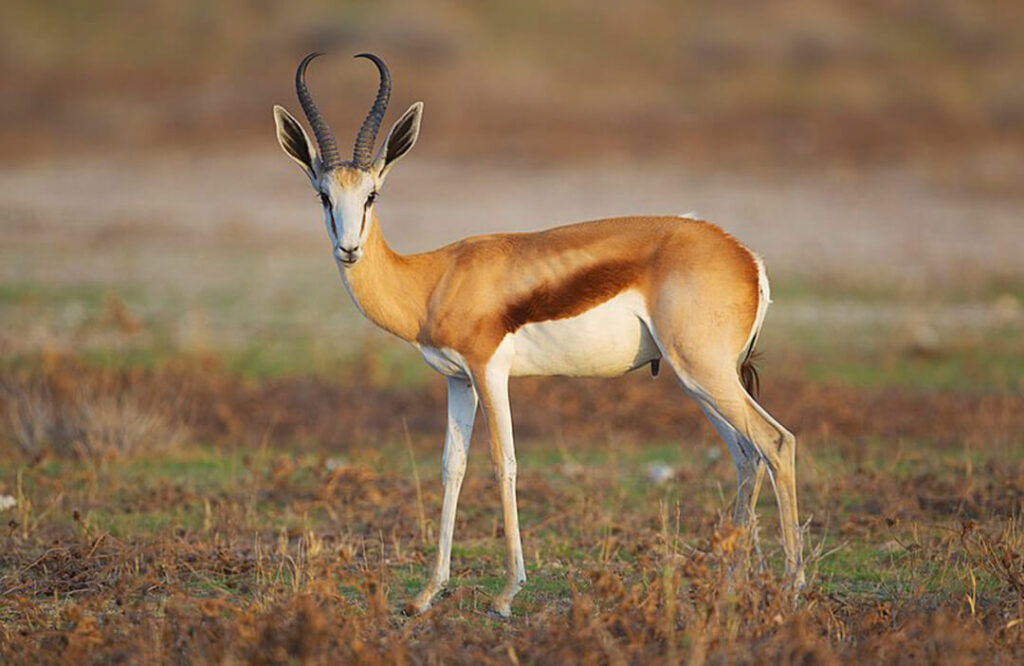The springbuck (Antidorcas marsupialis) is one of South Africa’s most iconic medium-sized antelopes. This graceful, agile, and strikingly marked antelope is the country’s national animal, and proud emblem of the South African rugby team, multiple World Cup Rugby Champions!
Springbuck have a very unique tuft of fur that can stand up on the antelope’s back when “pronking”. Pronking is when the springbuck jumps into the air, with stiff front and back legs and an arched spine. The name springbuck is translated from the Afrikaans words, “jumping buck.” This medium-sized antelope, when threatened, can clear a five-foot game fence with ease!
Often, once the antelope has been harvested, for roughly a minute or two the hairs on the springbuck’s back will stand up, giving off the most incredible and very unique sweet smell.
Certain South African plains game hunting safaris are custom-designed to successfully try and hunt all three-color variants of the Common Springbuck, namely the Copper, White, and Black Springbuck in one single safari, often referred to as the “Springbuck Grand Slam.” Game breeders are now breeding even more “Springbuck colors” and Royal and Coffee Spring are now also becoming available.
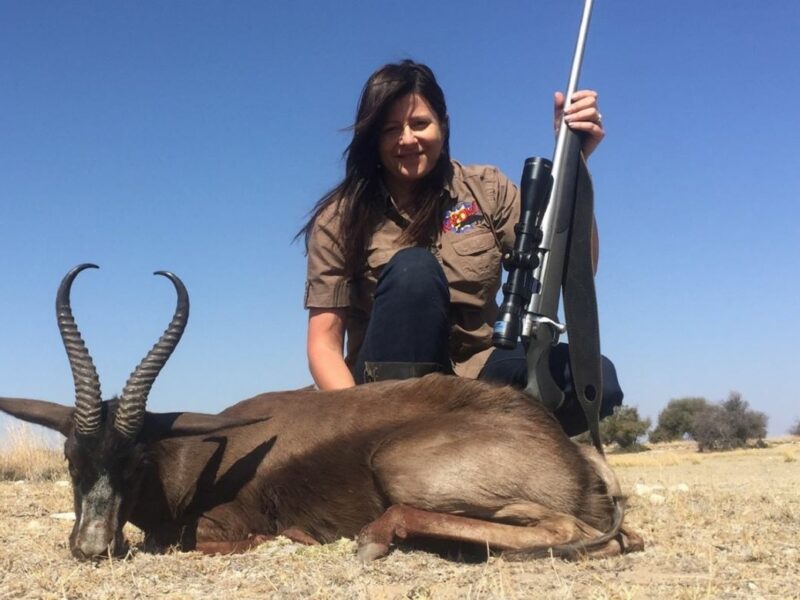
The above image shows a magnificent black springbuck ram that my wife Tamlyn hunted with her favorite weapon of choice, a 300 Win-Mag, loaded with 165-grain tips. This game hunting safari took place in the Northern Province of South Africa.
Note the open vegetation and the sparse brush and shrub. In this region of South Africa, the average shooting distance can vary between 100 yards and 300 yards. The horns on this springbuck ram were beautifully balanced and symmetrical, making it a gorgeous game hunting trophy.
[DYNAMIC-BLOGTABLEOFCONTENT]
The Best Springbuck Hunting Areas in South Africa
Springbuck naturally occur in most provinces of South Africa. Springbuck could not previously survive in the Limpopo or Mpumalanga areas due to Heartwater, a disease transmitted by Amblyomma ticks. Common springbuck were given blood transfusions for them to build immunity to the disease. Springbuck hunting in South Africa within these areas is often more expensive than in the local endemic areas. These springbuck are normally traded in in-game breeding programs and are worth more “alive than dead.”
The largest springbuck, in terms of body and horn size, is found in the Kalahari region of South Africa. When taking “long shots” of over 300 yards, it is best to consult with your professional hunter as both the male and female springbuck have horns.
Springbuck Hunting in South Africa: Frequently Asked Questions
What is the best Rifle for Springbuck Hunting in South Africa?
As the hunter may be shooting open areas and long ranges, the best rifle choice would be one with a flat trajectory. A recommended caliber would be a .243 or a .270. Larger rifles in the 30-caliber range, such as a 30.06, .308- and 300-Win Mag will also ensure a quick and humane kill on your African hunting trip.
Where is the best Shot Placement on the Springbuck?
The best shot placement to take on a springbuck is on the shoulder when it’s standing broadside to the hunter. The point of aim will be a third of the way up the front shoulder.
A headshot, except when culling is not advisable as the springbuck trophy will certainly be ruined.
Is Trophy Hunting Legal in South Africa?
Yes, trophy hunting is legal in South Africa. Each province within South Africa has its own set of regulations which are enforced and governed by the Department of Nature Conservation.
How much will a Springbuck Hunting Safari in South Africa cost?
A South African plains game safari, unless incorporated in the total safari hunting package will show trophy fees for additional antelope hunted as a separate line item. Springbuck trophy fees also cost more for color variants. Springbuck trophy fees also vary between the different provinces in South Africa.
Springbuck Trophy Hunting Costs (Average Price):
Common (Cape) Springbuck: US $450 to US $ 650
Copper Springbuck: US $ 850 to US $1500
Black Springbuck: US $550 to US $1000
White Springbuck: US $ 900 to US $1250
Plains game hunting in South Africa for springbuck normally includes other antelope such as black wildebeest, oryx (Gemsbuck), steenbuck, duiker, red lechwe, roan, and sable. These Africa plains game hunting areas are also well-known safari hunting grounds for dangerous game such as the Cape buffalo.
The below image shows a springbuck ram which was hunted by my son Keenan in the Kalahari, South Africa. Due to heavy rains, the long grass is very noticeable. Looking at the springbuck’s back, one can notice the “pronk” of the fur which is a spectacular feature.
Keenan used a Remington 30.06 loaded with 180 grains of factory Hornady SSTs. Notice also how the springbuck is also classified as “heavy in the body”. If memory is correct, these beautifully shaped horns measured 13 inches.

These beautiful antelope can be one tough hunt! The shooting distance in certain areas of South Africa can easily be over 350 yards, tough going for even a good marksman. This distance factor, combined with the springbuck’s natural ability to camouflage, can make a successful springbuck game hunting safari a challenge.
In South Africa, a hunting vehicle is often made use of, as the hunting areas often cover enormous expanses of ground. Hunters will regularly stop and glass the surroundings for a suitable trophy springbuck ram.
Once spotted, the hunter and outfitter will plan the stalk. Stalking a springbuck is not easy as the semi-arid conditions provide little cover. In certain areas, due to lack of cover, hunters will often hide in holes made by porcupines and warthogs to ambush the springbuck.
The best time to hunt a springbuck will be in the early morning just after sunrise, or late afternoon while the springbuck is feeding, and may just be a little “off-guard.” They are mostly found in large herds, making a successful stalk even more difficult to approach as there will be numerous ever-watchful and alert sentries on duty.
Bowhunting springbuck is normally done near supplementary salt licks, or mineral blocks on certain ranches or near waterholes in the more remote areas. African outfitters will build temporary or permanent blinds near these areas with the hope of ambushing the trophy Springbuck.
Considering that when bowhunting springbuck and the distance between the hunter and the springbuck is limited, this can result in an exceptionally challenging hunt, hence the drier winter months are preferred.
Springbuck Feeding Habits
Springbucks are generally water-independent, in other words they do not have to have access to water daily. However, if water, naturally or via artificial watering is available, springbuck will readily drink.
Springbuck, while being grazers and feeding on grasses, also gets the required moisture from herbs, fruit, seed pods, and leaves in the wetter months.
The below image of a Springbuck ewe was shot by my son Logan using a Remington 30.06, at a distance of roughly 150 yards. A walk and stalk method was used, due to the scrub and trees providing cover.
Notice the thinner bases of the ewe compared to that of the male springbuck. Looking at the bushveld in the background, grass in this region was not readily available and the springbuck was heavily reliant on leaves and foliage to provide substance.
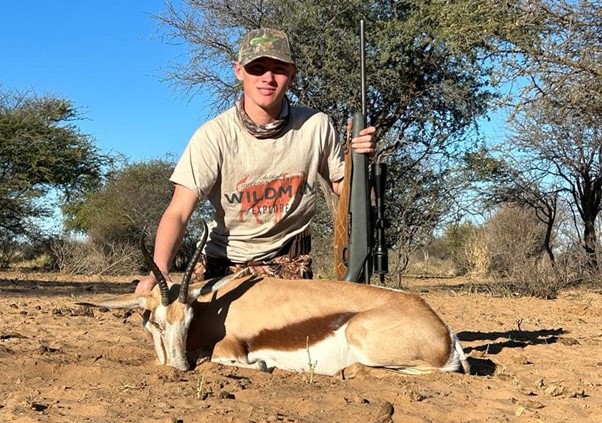
When is the Best Time to Book a Springbuck Hunting Safari in South Africa?
South Africa does not place any restrictions in terms of a specific springbuck hunting season. As such, springbuck hunting can take place throughout the year. Trophy hunting for South African plains game is normally conducted during the cooler months which run from April until August. During summer, the temperatures are high and this factor, along with plentiful rain does increase insect activity. Any hunter, having been on an Africa hunting trip and hunted in the long grasslands, during summer, will be able to share stories of just how irritating and unpleasant pepper tick bites can be.
Read more about “critters” and challenges when on an Africa hunting trip in the warm months.
During the cooler winter months, Springbuck also need to travel greater distances in search of feed, meaning that the hunter’s chance of bumping into the herd exponentially increases. The same applies to visiting waterholes. When packing for a springbuck hunting safari in winter, the hunter needs to remember that early morning and late afternoon/evening temperatures drop to be below 32 degrees Fahrenheit. As such it is essential that protective gear such as jackets, gloves, scarves, and a watch cap (beanie) are included with the hunting gear.
Trophy Quality of Springbuck in South Africa
The size of springbuck horns varies between South African provinces, with the largest being found in the Kalahari. A good size in my opinion for this area is between 13 and 15 inches (using the Rowland Ward method). The world record for a Springbuck is currently at 20 and 4/8th of an inch, which is incredibly huge. It is also advisable to check if African outfitters are billing a straight trophy price or a price per inch.
Some game ranches in South Africa are at present breeding them even bigger at way over twenty inches. In my opinion, these springbuck look rather absurd as nature did not intend for them to look this way. Thanks, but I will be happier with a 15-inch springbuck hunted elsewhere!
Springbuck, being naturally so strikingly marked, make for incredible game hunting trophies, whether full mount, shoulder mounts, or just skill mounts. Springbuck skins and horns are often used to make decorative tourist trinkets.
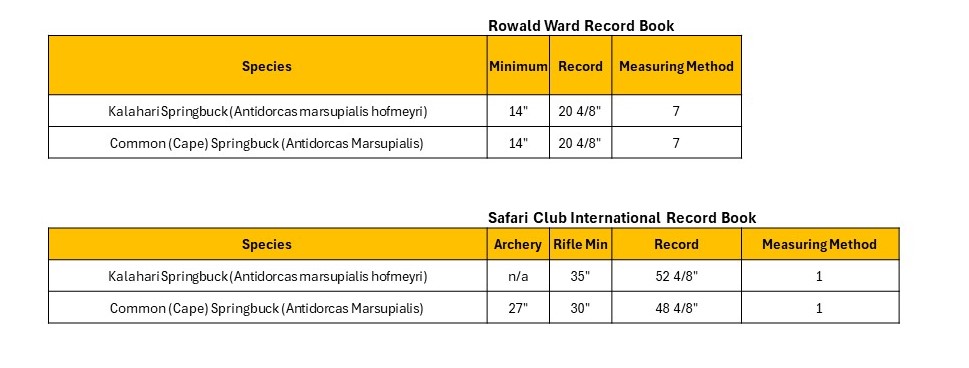
Fenced Ranches vs. Free Range when Springbuck Hunting in South Africa
Free range vs. Fenced hunts, is the debate that is forever ongoing! The reality is that on larger game ranches, it is almost impossible to keep a springbuck contained. In areas such as the Eastern Cape in South Africa, many ranches also breed cattle and the springbuck just jump over the fences.
While other ranches have game fences at a minimum requirement of seven feet and ten inches, porcupines, warthogs, and pigs regularly make holes in the bottom allowing the Springbuck to crawl underneath the fence. In South Africa, the law says that if the antelope is on your land, it belongs to the land owner. Whether ranch owners are breeding antelopes or Cape buffalo, securing the perimeter is an ongoing process.
This containment problem is good news for the springbuck populations as genetics are transferred between the breeding herds. Landowners in South Africa do not always have the best working relationships. On a previous game hunting safari in the Eastern Cape in the area surrounding Cradock, one of the members of our hunting safari discovered a young springbuck ram that had been caught in the fence and was still alive.
When radioing the outfitter asking what to do, the outfitter proceeded to ask which side of the fence it was on. The hunter confirmed that it was on the neighbor’s side, but he could just jump over and save the springbuck.
The outfitter advised the hunter to leave the springbuck to die as he did not want to interfere with the neighbor. Cruelty personified! We never hunted with that African outfitter again!
Slade hunted the trophy below near the town of Tosca, which is a well-known stop-over point when lion hunting in South Africa. He used his .308, loaded with a 165-grain Hornady bullet. Note again the beautiful “pronk” of the fur and the broken right horn. Luckily this area had good grass after heavy summer rains, so while grass and cover were plentiful, it was in the middle of winter so the infamous “pepper ticks” were not problematic.
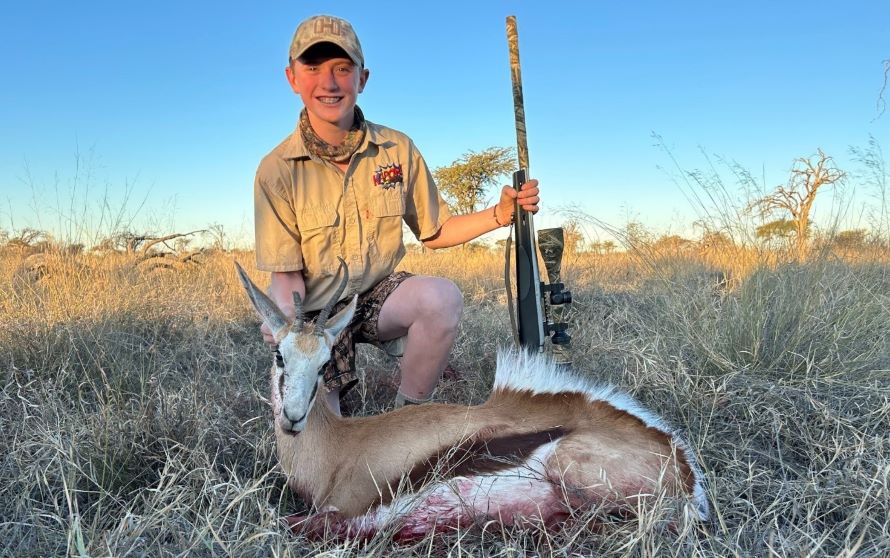
Is it Safe to go Springbuck Hunting in South Africa?
Yes, a hunting safari in South Africa is safe. International travelers will enter South Africa via Cape Town International Airport or Oliver Tambo International Airport in Johannesburg. Your African outfitter will collect you directly at the airport, which really are world-class with a large presence of both private security companies and government police officials.
Depending on the location of the safari, hunters will either travel to the hunting grounds making use of private air charter, domestic airlines, or by road transport.
The national roads are well maintained, and motorists must pay toll fees to SANRAL. The South African government, while experts in corruption and fraud, do however ensure these national roads are well maintained for travel and road safety purposes. When nearing remote hunting grounds, the road structure will change from tar or asphalt to stone and sand.
Are Springbuck Antelopes good to eat?
Springbuck meat, known as venison in South Africa, is in great demand as the meat is highly palatable. While the meat may not be exported due to international regulations, your outfitter’s chef, will most certainly know how to prepare this local delicacy.
The meat harvested from the carcass is processed into various cuts and below are some of the famous South African dishes and recipes:
- Roasted leg and shoulder joints.
- Flame grilled backstrap, also referred to as the tenderloin.
- Cubed meat, mixed with herbs and wine into a fire-cooked stew, known in South Africa as a “potjie”.
- Thin, well-spiced breakfast sausages pan-fried and fire seared.
- Off cuts are minced into pies, or South African “vetkoek”.
- The liver is soaked in milk, thinly sliced and pan-seared, mixed with garlic, chili, spices, and cream, and served as a breakfast side (my all-time favorite!).
- Springbuck meat is also turned into sausage, spiced, mixed with fat, and served as a dried sausage, famously known as droewors in South Africa
- Biltong, or as known in the USA as jerky. Many hunters will tell you of the fond memories, of an evening relaxing around a campfire, watching the sunset, chewing on a piece of Springbuck biltong enjoying the ambiance of the African safari. Of course, a cold beer or Cape-aged wine is always in hand!
The below image shows yet another rewarding dish following a successful Springbuck hunt, namely carpaccio. The springbuck meat is thinly sliced and served raw, often with fresh herbs including rocket and parmesan cheese. A real treat after a hard day of hunting!

Is it Recommended that I take my Family on a Hunting Safari in South Africa?
If there is one that that most South Africans love besides hunting, fishing, drinking beer & wine, and having a traditional “braai,” is family.
Outfitters cater to non-hunters, first-time hunters, and children, and hunting lodges in South Africa are specially designed to include additional activities, all varying based on location.
Activities for family members to enjoy can include:
- Day Trips to local towns and tourist attractions
- Horse riding
- Swimming
- Clay pigeon shooting
- Hot air ballooning
- Water sports
- Salt and freshwater game fishing
- Health and massage spas
On completion of the Africa hunting trip, it is suggested that should time and resources allow, the safari be extended by a few days to include other tourist attractions that South Africa is famous for, such as a visit to Cape Winelands, Kruger National Park, Cradle of Mankind, Drakensberg Mountains, to name but a few.
During the late 1800s, enormous herds of springbuck, called “trekbokke” (which are herds of migrating springbuck) traversed the beautiful country of South Africa. Springbuck herds today are still in their thousands in certain areas of the country.
South Africa is a premier game hunting destination, due to service offerings, hospitality, trophy animals, and affordability. Book your Africa hunting trip for this iconic antelope, you will not be disappointed.
Read more about my South African plains game hunting experience in the Kalahari.
Author: PC van Wyk
